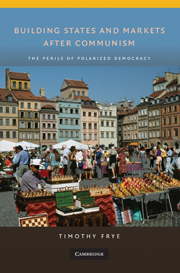Book contents
- Frontmatter
- Contents
- List of Tables and Figures
- Acknowledgments
- Introduction
- 1 The Political Logic of Economic and Institutional Reform
- 2 Political Polarization and Economic Inequality
- 3 The Pace and Consistency of Reform
- 4 Political Polarization and Economic Growth
- 5 Political Polarization and Policy Instability: The View from the Firm
- 6 Nationalism and Endogenous Polarization
- 7 Russia: Polarization, Autocracy, and Reform
- 8 Bulgaria: Polarization, Democracy, and Reform
- 9 Poland: Robust Democracy and Rapid Reform
- 10 Uzbekistan: Autocracy and Inconsistent Gradualism
- 11 Conclusion
- References
- Index
- Titles in the series
10 - Uzbekistan: Autocracy and Inconsistent Gradualism
Published online by Cambridge University Press: 05 June 2012
- Frontmatter
- Contents
- List of Tables and Figures
- Acknowledgments
- Introduction
- 1 The Political Logic of Economic and Institutional Reform
- 2 Political Polarization and Economic Inequality
- 3 The Pace and Consistency of Reform
- 4 Political Polarization and Economic Growth
- 5 Political Polarization and Policy Instability: The View from the Firm
- 6 Nationalism and Endogenous Polarization
- 7 Russia: Polarization, Autocracy, and Reform
- 8 Bulgaria: Polarization, Democracy, and Reform
- 9 Poland: Robust Democracy and Rapid Reform
- 10 Uzbekistan: Autocracy and Inconsistent Gradualism
- 11 Conclusion
- References
- Index
- Titles in the series
Summary
In September 1993 President Karimov dedicated a statue to Timur (Tamerlane) on the site where a monument to Karl Marx had previously stood in the centre of Tashkent.…The new Timur is thus the centerpiece of an Uzbek national ideology based on the idea that the Uzbeks have been, since time immemorial, the dominant political and cultural force in Central Asia. Parallels between Karimov and Timur have frequently been drawn in the Uzbekistani press.
Melvin (1999: 46)Throughout the period under study Uzbekistan has been ruled by an old-left executive in a nonpolarized autocracy. As expected, Uzbekistan pursued a mix of inconsistent gradual policies emphasizing state-led development, slow privatization, and vast state intervention in the economy to support the executive's core constituency in state-owned industry and agriculture. Fifteen years into the transformation, land was state owned, companies producing the largest export commodities, cotton and gold, were largely in state hands, protection against foreign goods was vast, and economic policy was widely perceived to be subject to arbitrary changes. High market prices for gold and cotton in the first half of the 1990s helped to prop the Uzbek economy and provide fairly generous transfers, but ultimately, the country's inconsistent gradual policies failed to generate sufficient growth to maintain high levels of transfers.
- Type
- Chapter
- Information
- Building States and Markets after CommunismThe Perils of Polarized Democracy, pp. 229 - 243Publisher: Cambridge University PressPrint publication year: 2010

